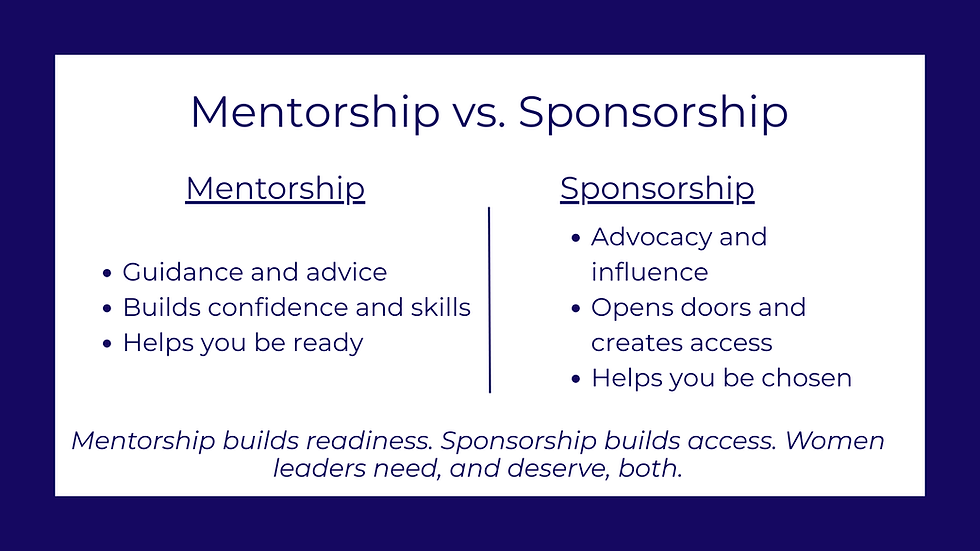From Mentorship to Sponsorship: The Shift Women Leaders Need
- Shannon Reynolds
- Sep 22
- 3 min read
For decades, mentorship has been celebrated as a key factor in helping women advance in leadership. And it matters. Research shows that employees with mentors are more likely to advance and experience salary growth, with 25 percent seeing salary-grade changes compared to those without mentors¹. Mentorship provides guidance, confidence, and perspective that every professional can benefit from.
But mentorship alone is not enough.
According to the Harvard Business Review, the real difference-maker in career advancement is not just advice, but advocacy2. Sponsorship is what moves women beyond readiness into opportunity. Sponsors do more than coach. They recommend, promote, and put their reputation on the line to help someone step into new leadership roles, gain visibility, or land transformative clients.
Why Mentorship Matters, But Falls Short
Mentorship is invaluable for developing skills and fostering self-confidence. A mentor can provide feedback on a presentation, suggest strategies for navigating office politics, or share lessons learned from experience.
Yet mentorship often stops at the level of preparation. A mentor might help you prepare, but that does not guarantee you will be chosen. The Chartered Management Institute found that while 19 percent of women had mentors, only 3% had sponsors3. This imbalance leaves many women “over-mentored and under-sponsored,” prepared but still waiting outside the rooms where decisions are made4.
The Power of Sponsorship
Sponsorship takes mentorship one step further. It is advocacy with intent. McKinsey’s Women in the Workplace 2024 report found that while women now represent 29 percent of C-suite positions, up from 17 percent a decade ago, representation at the manager level has stalled5. Without active sponsorship, women often struggle to break through the critical mid-career bottleneck.
Other studies highlight why. In finance, men and women ask for promotions at similar rates, yet men receive far more “gifted advancements” — opportunities handed to them informally through networks and advocates6. These “gifts” are sponsorship in action. Women miss out not because they lack talent or ambition, but because fewer leaders are putting their names forward.
Sponsorship, in short, is the hidden currency of advancement. It accelerates careers by opening doors that skill alone cannot unlock.
Why Women Need Sponsorship Now
Today’s high-performing women are not asking for more advice. They are asking for access. They do not need someone to simply validate their readiness; they need someone to champion their opportunities.
Sponsors give women visibility in rooms where they are not present. They advocate for the stretch assignment, the board appointment, and the next big client. They use their influence not just to advise, but to propel. For women who have historically been overlooked, this kind of advocacy is the difference between steady progress and transformative leaps.

How WOIIA Puts Sponsorship Into Action
This is why Women of Impact, Influence, & Action (WOIIA) was built. We exist to fill the gap between mentorship and sponsorship.
Our councils are not designed to be another networking group or mentorship circle. They are structured, high-trust environments where each seat is intentional, and each member is committed to more than advice-giving. At WOIIA, members actively champion one another’s growth. They sponsor.
Here, your ambition does not need translation. Your influence is not minimized. Instead, your peers advocate for your advancement, creating tangible opportunities, not just encouragement.
Mentorship builds readiness. Sponsorship builds access. Women leaders need, and deserve, both.
At WOIIA, we do not just guide women forward. We open doors, amplify influence, and create the kind of collective sponsorship that changes careers, companies, and communities.
Sources




Comments